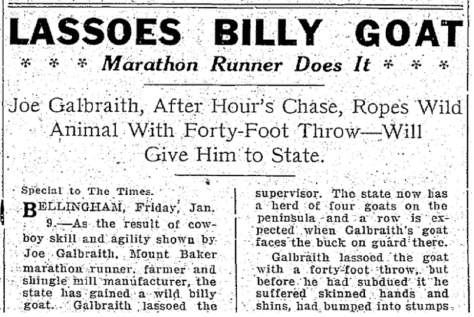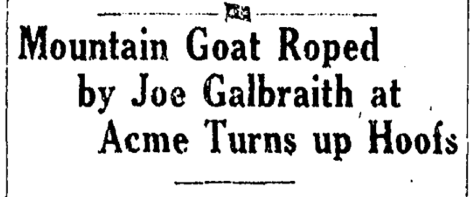
The Mountain Goat That Wouldn’t Go
Whatcom County Farmer’s Lassoed Billy Was To Be Part Of 1925’s Olympic Peninsula Introductions
There’s goat roping, and then there’s mountain goat roping.
Yes, the latter is as much of a cluster as it sounds.

(DETAIL, “MOUNTAIN GOAT,” 1951, UNKNOWN PHOTOGRAPHER, GENERAL SUBJECTS PHOTOGRAPH COLLECTION, 1845-2005, WASHINGTON STATE ARCHIVES, DIGITAL ARCHIVES, HTTP://WWW.DIGITALARCHIVES.WA.GOV, ACCESSED JUNE 19, 2019)
With Washington’s various wildlife managers just about to begin year two of an effort to move the wild goats in the Olympics over to the species’ home range in the Cascades, I want to draw your attention back to the mid-1920s and the veritable “fifth Beatle” of the peninsula’s original quartet.
As she works on her genealogy projects, my mom occasionally forwards me old newspaper articles about Northwest fish and wildlife back in the day.
(You may remember last year’s Great Elk Drive Of Snohomish County).
Mom’s latest finds detail the capture of what would have been one of the first five members of the herd, a particularly ornery — not to mention wayward — billy.
She happened across the stories while researching friends of her grandfather on her mother’s side. My great-grandpa Smith Miller worked for various local logging outfits back in the first half of the 1900s, down in National, up on Lake Shannon, and while in the North Cascades he became acquainted with the Galbraith clan.
They were a collection of tough hombres — timber cruisers, mill builders and farmers, as well as Mom says “inveterate hikers and woodsmen who would race up the slopes of Mt. Baker” as part of a short-lived local marathon that became the inspiration of today’s Ski to Sea relay.
Joe Galbraith won the inaugural race in summer 1911, which also included a road rally from Bellingham, and during the final weather-marred run to the top of the volcano and back down two Augusts later, his cousin Vic (who would years later give my uncle, then an infant, a backpack as a present) had to be rescued from a 40-foot-deep crevasse.
A SCREENSHOT OF A HEADLINE AND STORY FROM A JANUARY 1925 EDITION OF THE SEATTLE DAILY TIMES, NOW THE SEATTLE TIMES, DETAILS THE CAPTURE OF ONE OF THE ORIGINAL MOUNTAIN GOATS RELEASED IN THE OLYMPICS FROM THE NORTH CASCADES. (GENEAOLOGYBANK.COM)
THIS PARTICULAR TALE OCCURRED IN 1925, when Joe lived on his farm outside the town of Acme, which is east of Bellingham and north of Mt. Vernon, and it involves a mountain goat that inexplicably turned up in his back 40.
Details come from the pages of the Bellingham Herald and the Seattle Daily Times, today’s Fairview Fannie, as well as the journal The Murrelet.
According to reporters’ stories, on January 4, the first Sunday of 1925, Galbraith spotted the billy lying in one of his fields and immediately set out to lasso it, per the Herald.
What followed was described by the Daily Times as “an hour’s rumpus scattered over a ten-acre patch,” a battle that apparently left both the goat roper and ropee pretty banged up.
“Galbraith lassoed the goat with a forty-foot throw, but before he had subdued it he suffered skinned hands and shins, had bumped into stumps and had knocked over a fence post or two,” the paper reported.
It’s not clear why the billy had come so far down into the lowlands, but the Herald says it was believed to have been chased there, “possibly by coyotes or a cougar,” perhaps off of its winter range, or maybe it was stricken with the wanderlust males of species get, or something else entirely.
Koma Kulshan — the native name for Mt. Baker — and its environs have long been a stronghold for Oreamnos americanus; in summer 2016, a whopping 90 were photographed on a single snowfield.
After subduing it, Galbraith tied the goat up and word of its capture quickly reached state game and fish managers.
They had just recently acquired four Canadian mountain goats via British Columbia from the Banff area (other records say the Selkirks to the west), and released them on New Year’s Day at the foot of Mount Storm King by Lakes Crescent and Sutherland outside Port Angeles.
“When the crates were first opened the goats refused to come out, being somewhat dopey from their long confinement. First one large one came out and (Olympic Forest Reserve ranger Chris) Morganroth (sic) attempted to photograph it. Down went the head and the goat made a plunge for Morganroth. Right there Morganroth proved that a man who can escape death by airplane can certainly beat a goat to safety. After the misdirected lunge the goat went up the rock cliff and found a crag satisfactory to him, and looked over Lake Crescent and surrounding country, going higher up a short time afterward.” —The Murrelet, January 1925.
Between J.W. Kinney, who supervised hunting and fishing in Washington at the time, local federal forestry officials and leadership of the Klahhane hiking club, it was believed the animals would do quite well in the peninsula’s rugged heights, according to The Murrelet, a local biologist journal now published under another title.
So Kinney sent word for Joe Galbraith to hold onto his goat “until such time as it has regained its strength” following its flight out of the North Cascades and its battle with the farmer, and then arrangements would be made to ship it across Puget Sound.
Ultimately, 12 goats were set loose in the Olympics between early 1925 and some point later in the decade, according to The Murrelet, with most coming from Alaska as part of a swap for elk.
JANUARY 6 HEADLINE FROM THE BELLINGHAM HERALD. (GENEAOLOGYBANK.COM)
FAST FOWARD 90-PLUS YEARS AND TODAY’S state wildlife managers along with the National Park Service, U.S. Forest Service and various tribes are gearing up to for another round of translocating the several hundred descendants of those animals roaming the slopes of Hurricane Ridge, Mt. Olympus and other peaks over to the Cascades.
The idea is to reduce the environmental damage the nonnative species is causing to plants and terrain in the Olympics and bolster herds in their native habitat along the spine of the Evergreen State.
“We’ll start captures on July 8, go for 12 days; then start again August 19 for another 12 days,” says WDFW’s goat manager Rich Harris.
He says that based on last September’s two-week effort that saw 98 successfully moved, twice as many could be caught and transferred to the North and Central Cascades this summer.
Overall 115 were captured in 2018, with eight dying in the process, three deemed to be unfit and were euthanized, and six parentless kids transferred to Northwest Trek.
The other 68 nannies and 30 billies were released at five sites, including two near Darrington, one north of Rainy and Washington Passes in the North Cascades, one northwest of Kachess Lake by Snoqualmie Pass, and one in the headwaters of the Cedar River southwest of Snoqualmie Pass.
Two radio-collared goats were taken down by cougars, Harris says, while at least one of the Cedar animals went for a walkabout and showed up on Rattlesnake Ledge near North Bend last fall.
The translocation is expected to continue again next year before lethal removal is considered for any remaining cantankerous holdouts.
SPEAKING OF, THAT GOAT-ROPING ESCAPADE was thought to be just a warm-up act for the back-pasture billy.
“… (A) row is expected when Galbraith’s goat faces the buck on guard there” in the Olympics, the Daily Times wrote.
But it never made the trip to join 1925’s other four on the peninsula.
A “week to the hour” after its capture, it found itself “seeking eternal rest and evergreen pastures in a new stamping ground; perhaps where all goats go when they die …,” reported the Herald.
“… Joe’s goat, after spending a week a barn pending deportation to the Olympic mountains by the state game commission turned up its hoofs and passed out,” the paper stated.
The billy was said to announce the abrupt change of plans with a “feeble bleat.”
HEADLINE FROM THE JANUARY 13, 1925 BELLINGHAM HERALD. (GENEAOLOGYBANK.COM)
Despite the best efforts of a local veterinarian and the local game warden, the animal couldn’t be revived, the Herald stated.
But all was not lost. Shortly afterwards its head, horns and coat were removed.
That October, what was billed as “the most striking exhibit ever,” a mounted mountain goat, was given to the local chamber chamber of commerce by the county game commission and Galbraith, reported the Herald.
Who knows why the billy that turned up in the lowands actually died, but the last story my mom found said it was estimated to have stood three and a half feet tall at the shoulders, would have dressed out at 250 pounds, and was estimated to be 15 years old, making it a very old goat indeed.
But then again, maybe it just didn’t want to leave its home mountains for strange heights.
